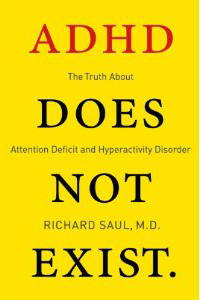This post has been read 2406 times!
March 20, 2014- By Steven E. Greer, MD
Richard Saul, MD strived to be provocative with his new book ADHD Does Not Exist. He not only succeeded, but also backed up his bold assertion with ample sound logic and supporting data.
This is an important book because ADHD, as defined by the psychiatry guidelines in the DSM-V, can now be diagnosed in 5% of the United States population. Up to 11% of all children have been diagnosed. Up to 20% of high-school-age boys have been diagnosed with ADHD: a 40% rise in just ten years.
Dr. Saul estimates that the monetary cost of this epidemic of ADHD is as high as $50 Billion. $14 Billion, or 27% of that $52 Billion, was spent on families related to the ADHD “patient”. Another $12 Billion was spent on schools and other health related costs.
Surprisingly, Dr. Saul avoids the topic of federal policy that led to the ADHD explosion. In the late 1990′s, the Clinton administration allowed the HHS to classify ADHD as a disability, opening the flood gates of funding for schools and families. ADHD is now a lucrative industry fueling a powerful bureaucracy.
The book begins by explaining why ADHD does not exist in anyone. Dr. Saul explains that ADHD is just a diagnosis of symptoms, as defined rather arbitrarily by a panel of psychiatrists. It is a completely man-made phenomenon. Moreover, the people making the “diagnosis” are often not medical professionals, but rather teachers or counselors, checking off boxes of criteria that are very subjective.
In Part 2 of the book, he explains in detail what the most common underlying medical problems are that cause the “ADHD” symptoms. He explains how vision problems, thyroid disorders, substance abuse, depression, fetal alcohol syndrome, good old fashioned low IQ, and many other treatable maladies are the root cause of the fidgety distracted person.
The book explains the medical dangers of taking the ADHD stimulants. Short-term adverse events include weight loss, sleep loss, and irritability leading to social problems. Long-term, the undeveloped brain of the young child is likely altered by stimulants. Children on the drugs often develop lifelong habits.
Dr. Saul completes the book in Part 3, with useful steps for identifying the real causes of the ADHD symptoms, and addressing them. In many cases, lifestyle changes can do the trick. Improving sleep and exercise patterns works wonders, and, of course, cessation of drugs and alcohol is imperative.
How ADHD became so prevalent in the U.S.
Allen Frances, MD, highly critical of approved DSM 5 psychiatry “bible”
